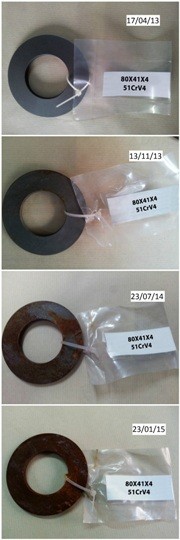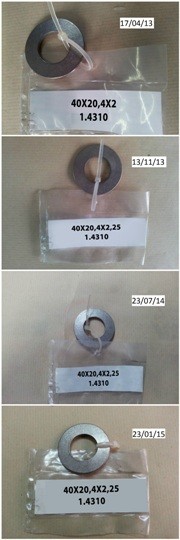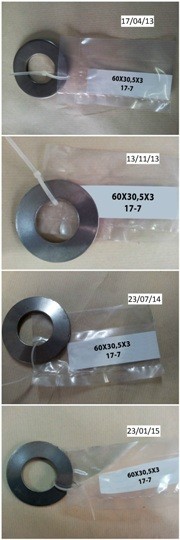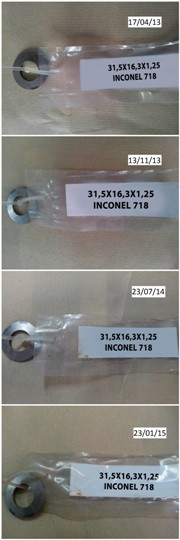Compare different disc springs degradation depending on its material function was the first objective. After almost 2 years of process, partly evident and significant results have been gotten.
The experiment consists on leaving disc springs of different material and sizes exposed to the environment during a long period of time, exactly 21 months. The environment: a courtyard located in Barcelona City (Spain). They have only been subjected to environmental conditions: air, rain and the city’s temperature changes. Results come from the effects produced in different pieces by the environment. Once or twice a month some photographs were taken to preserve the corrosion process on the pieces. It’s important to emphasize washers always exposed to environment temperature have not been subjected to any effort during the assay.
Climatic agents that affect the most are oxygen and water. The study was realized in our commercial place from less than 2 km from the sea with its moisture level included. It’s important to keep in mind that every climate is different so the effect on materials too. Damp and warm climates speed up corrosion effects.
Springs of the test are of four different materials: DIN 1.8159 (51CrV4), DIN 1.4310 (AISI 301), DIN 2.4668 (Inconel 718) and DIN 1.4568 (AISI 631 or also denominated 17-7PH). The 51CrV4 is the less resistant material due to its material composition (steel’s alloy to chromium). This alloy is used for applications where is previously known that it will not be exposed to corrosive agents. However the 1.4310, the 17-7PH and the Inconel are especially made to resist external agents. In the experiment, an excessive difference between them it’s not appreciated due to the time has not been enough to show some sign of corrosion resistance. Nevertheless, we can affirm Inconel 718 is the most resistant material, followed by 301 while 17-7ph is the less resistant. By the way, 17-7 PH is occasionally used instead of 1.4310 because of being a cryogenic material with an extended thermic range (from -196ºC until 300 ºC). Related to thermic resistance, Inconel is more efficient (from -260ºC until 700ºC). As you can appreciate on the pictures, those three materials are completely resistant even though the environmental effects.
In 51CrV4 corrosion effects due to the time are clearly seen in the pictures, above all from 8 months after its outside exposure. There are chiefly stains rust and they go expanding to the washer surface during the following months. In some cases, this wear deforms the washer mainly on the edge.
AISI 301, 17-7PH as well as Inconel 718 are maintained immutable. Notable effects of corrosion are not appreciated in any of those 3 materials. Some stains can be seen but they are not proof of a wear which could affect the disc springs working.
In conclusion, the only material which is weak against environment is 51CrV4. The other ones work perfectly.
Below we can see the progress of different kind of disc springs on these pictures which have been taken during 17/04/13, 13/11/13, 23/07/14 and 23/01/15 as well as their chronological order:
You can click to increase any picture
51CrV4 |
1.4310 |
17-7PH |
Inconel 718 |
|---|---|---|---|
 |
 |
 |
 |

¿Qué opinas sobre este tema?